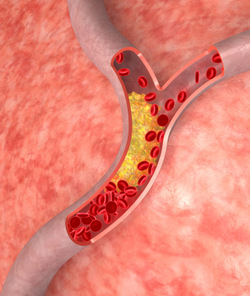
A new national guideline for managing blood cholesterol in people at risk of heart attacks and strokes changes the focus from aiming strictly for an ideal LDL – or, bad cholesterol level – to a more personalized approach. It optimizes the intensity of the treatment based on each person’s risk, meaning some individuals may need a higher dose of statins, while others, who aren’t likely to benefit from medication, may just be “prescribed” a healthier diet and lifestyle.
“Some people want to put statins in the water; others don’t want anybody to get a statin,” said Neil Stone, MD, the Bonow Professor of Medicine at Northwestern University Feinberg School of Medicine and chair of the expert panel that wrote the new guideline. He also is a cardiologist at Northwestern Memorial Hospital. “Our goal is to treat more people appropriately with the right intensity of therapy.”
The guideline on new management of blood cholesterol to prevent atherosclerosis, hardening, and narrowing of the arteries, was published Nov. 12 by the American College of Cardiology and the American Heart Association. Atherosclerosis is when plaques comprised of fat, cholesterol, and calcium develop and eventually block key arteries in the circulation.
The cholesterol guideline is one of four new sets of prevention guidelines to reduce cardiovascular disease, the leading cause of death and disability in the U.S.
“The likely impact of the recommendations is that more people who would benefit from statins are going to be on them while fewer people who wouldn’t benefit from statins are going to be on them,” Stone said.
The new guideline uses the highest quality scientific evidence – randomized, controlled trials – to focus treatment of blood cholesterol on those likely to benefit most, Stone said.
The new guideline recommends moderate- or high-intensity statin therapy for these four groups:
- Patients with cardiovascular disease
- Patients with an LDL, or “bad” cholesterol level, of 190 mg/dL or higher
- Patients with type 2 diabetes between 40 and 75 years old
- Patients with an estimated 10-year risk of heart attack and stroke due to atherosclerosis risk of 7.5 percent or higher who are between 40 and 75 years old. (The report provides a new formula for calculating 10-year risk).
“These are the four groups for which there is a large body of evidence that appropriate therapy will truly reduce heart attack and stroke,” Stone said. “They can benefit most from it.”
The panel focused on statins because a review showed they are the most effective cholesterol-lowering drugs and had the lowest rate of safety issues. Evidence showed it’s most effective to focus on a healthy lifestyle along with a higher dose of statins, eliminating the need for additional cholesterol-lowering medications.
“A healthy lifestyle is particularly important in young people who can help prevent high cholesterol and heart disease later in life with a healthy diet and exercise today,” Stone said.
Stone’s goal is for the new guidelines to prompt a discussion between a patient and physician about whether she is at risk for a heart attack and stroke and – if so – what is her optimal regimen? If the patient is not at risk now, what can she do to prevent becoming at risk as she ages?
“If we can do that, we’ll have accomplished a lot,” Stone said.






